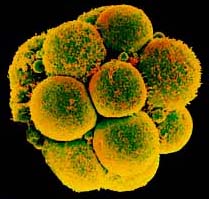There are a number of challenges that prevent stem cells from
being the medical panacea that they promise to be. Beyond the ethical concerns
that plague the research, there are a number of practical difficulties in
effectively applying this research. For example, in mature adults the occurrence
of non-differentiated pluripotent cells suitable  for
use in research is exceedingly rare. While the scarcity of these cells is
not variable, more efficient detection methods will greatly improve the
productivity of the research. Furthermore, there has been little application
in human subjects as a majority of the research has been conducted on small
mammalian animals such as mice. The main obstacle here is time, as until
we are sure of the full repercussions of the inclusion of foreign stem cells
into a mature adult we cannot make the theory into application. Even if
the aforementioned challenges are overcome, the possession of a valid stem
cell line does not guarantee any practical application. The reason for this
is that the position of a specific gene switch, which determines the identity
of a cell, has not yet been determined. The lack of such a switch prevents
controlled differentiation of stem cells in a laboratory environment. Finally,
assuming that technology is able to surmount these obstacles, the potential
that the resultant stem cell tissue will be rejected by the recipient is
extremely high, pending major modifications to either the immune system,
the cells themselves, or both. In summation, much of the research in this
field lies ahead before practical medical applications can be realized. for
use in research is exceedingly rare. While the scarcity of these cells is
not variable, more efficient detection methods will greatly improve the
productivity of the research. Furthermore, there has been little application
in human subjects as a majority of the research has been conducted on small
mammalian animals such as mice. The main obstacle here is time, as until
we are sure of the full repercussions of the inclusion of foreign stem cells
into a mature adult we cannot make the theory into application. Even if
the aforementioned challenges are overcome, the possession of a valid stem
cell line does not guarantee any practical application. The reason for this
is that the position of a specific gene switch, which determines the identity
of a cell, has not yet been determined. The lack of such a switch prevents
controlled differentiation of stem cells in a laboratory environment. Finally,
assuming that technology is able to surmount these obstacles, the potential
that the resultant stem cell tissue will be rejected by the recipient is
extremely high, pending major modifications to either the immune system,
the cells themselves, or both. In summation, much of the research in this
field lies ahead before practical medical applications can be realized. |

 for
use in research is exceedingly rare. While the scarcity of these cells is
not variable, more efficient detection methods will greatly improve the
productivity of the research. Furthermore, there has been little application
in human subjects as a majority of the research has been conducted on small
mammalian animals such as mice. The main obstacle here is time, as until
we are sure of the full repercussions of the inclusion of foreign stem cells
into a mature adult we cannot make the theory into application. Even if
the aforementioned challenges are overcome, the possession of a valid stem
cell line does not guarantee any practical application. The reason for this
is that the position of a specific gene switch, which determines the identity
of a cell, has not yet been determined. The lack of such a switch prevents
controlled differentiation of stem cells in a laboratory environment. Finally,
assuming that technology is able to surmount these obstacles, the potential
that the resultant stem cell tissue will be rejected by the recipient is
extremely high, pending major modifications to either the immune system,
the cells themselves, or both. In summation, much of the research in this
field lies ahead before practical medical applications can be realized.
for
use in research is exceedingly rare. While the scarcity of these cells is
not variable, more efficient detection methods will greatly improve the
productivity of the research. Furthermore, there has been little application
in human subjects as a majority of the research has been conducted on small
mammalian animals such as mice. The main obstacle here is time, as until
we are sure of the full repercussions of the inclusion of foreign stem cells
into a mature adult we cannot make the theory into application. Even if
the aforementioned challenges are overcome, the possession of a valid stem
cell line does not guarantee any practical application. The reason for this
is that the position of a specific gene switch, which determines the identity
of a cell, has not yet been determined. The lack of such a switch prevents
controlled differentiation of stem cells in a laboratory environment. Finally,
assuming that technology is able to surmount these obstacles, the potential
that the resultant stem cell tissue will be rejected by the recipient is
extremely high, pending major modifications to either the immune system,
the cells themselves, or both. In summation, much of the research in this
field lies ahead before practical medical applications can be realized.